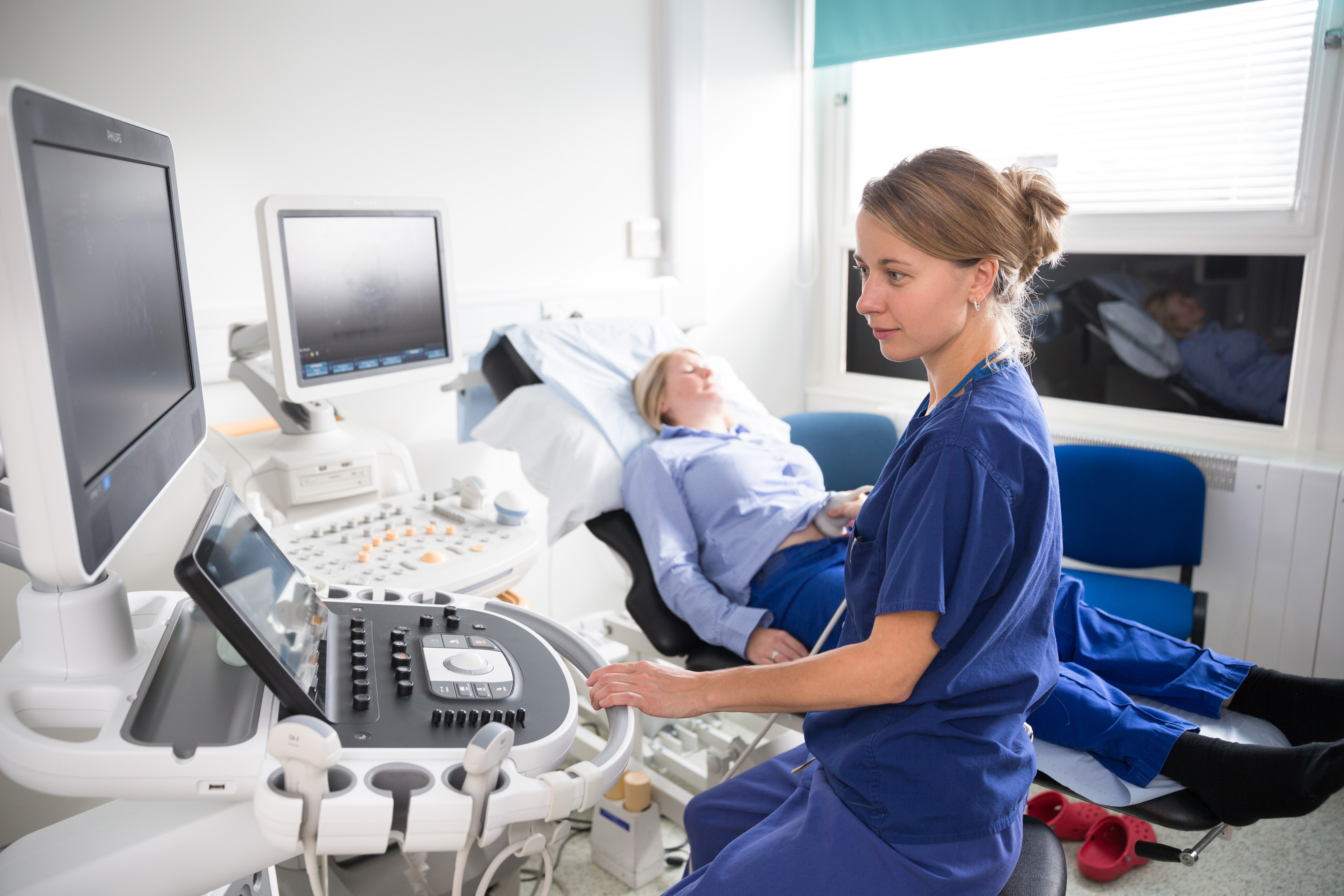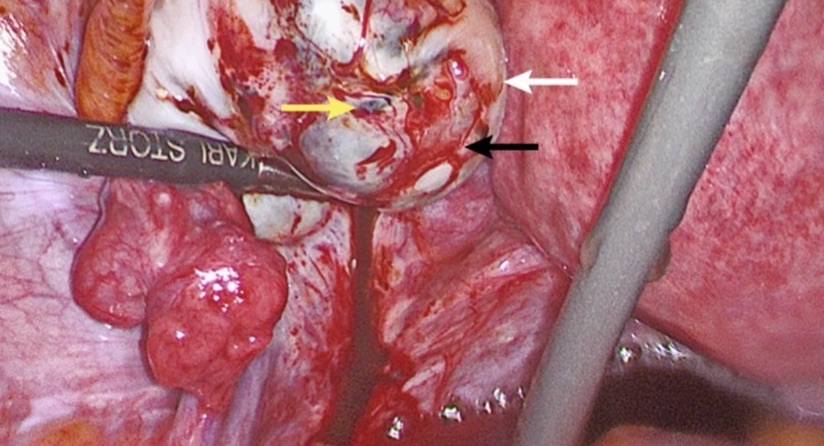Diagnosis
Endometriosis can be diagnosed through medical examination, imaging (MRI), or analysis of biomarkers (blood and urine tests). The gold standard, however, is a laparoscopy (key hole surgery).
Endometriosis is defined as the presence of endometrium-like tissue, i.e. the uterine lining, outside the uterus. In the vast majority of cases endometriotic tissue (lesions) are found in the abdomen, in particular in the pelvis of women. Only rarely endometriosis is found in other areas of the body. The abdominal lesions can be singular or multiple, have different colours (mostly red, clear, brown, black/blue or white), and lie superficially or invade deeper tissues or surrounding organs. Currently most people assume that three different types of abdominal endometriosis exist:
- Peritoneal endometriosis (superficial deposits on the lining of the abdominal wall)
- Ovarian endometriotic cysts (also known as endometriomas or ‘chocolate cysts’)
- Deep infiltrating endometriosis (nodular disease, infiltrating surrounding tissue).
 The revised American Fertility Society and American Society of Reproductive Medicine staging system of endometriosis is based on a points system that takes into account location, extent and depth of disease in relation to pelvic structures.
The revised American Fertility Society and American Society of Reproductive Medicine staging system of endometriosis is based on a points system that takes into account location, extent and depth of disease in relation to pelvic structures.
Organs such as the uterus, fallopian tubes and ovaries as well as structures that include the ovarian fossae (the shallow depression on the lateral wall of the pelvis in which the ovary lies), uterosacral ligaments, rectovaginal septum, pouch of Douglas (the portion of the peritoneal cavity between the rectum and the posterior wall of the uterus and the uterosacral ligaments) and uterovesical fold (the shallow depression of the peritoneum between the uterus and bladder) are often affected. Lesion size can range from punctate spots millimetres in size to nodular structures of a few centimetres and ovarian cysts (endometrioma) the size of grapefruits. Stage I (minimal, 1–5 points) usually comprises few superficial endometriotic spots or adhesions. Stage II (mild, 6–15 points) can be a few, deep peritoneal lesions solely or in combination with superficial lesions and filmy adhesions. Stage III (moderate, 16–40 points) often includes an endometrioma by itself or in combination with superficial or deep endometriosis and/or dense adhesions. Stage IV (severe, >40 points) is often characterised by all of the above as well as bilateral ovarian endometrioma and/or dense adhesions that can lead to a partial or complete obliteration of the lesser or true pelvis (the structure that contains all the pelvic organs). Importantly, the severity of the disease according to this system does not correlate with the severity and location of symptoms.
Medical History
Generally, as doctors and nurses we have various tools to diagnose a condition. Studies have shown that women with endometriosis often suffer from certain signs and symptoms. These include:
- Dysmenorrhea (painful periods)
- Dyspareunia (pain during sexual intercourse)
- Dysuria (pain when emptying the bladder)
- Dyschezia (pain when emptying the bowels)
- Non-cyclical abdominal pain
- Chronic Pelvic Pain
- Chronic fatigue
Other specific patient history indicators of endometriosis are the following factors:
- Family history: First-degree relative with endometriosis
- Adolescent history: Severe primary dysmenorrhea and/or early age of menarche
- Low BMI
- Cyclic pain that worsens during the menstrual cycle
- Infertility
Unfortunately, none of the above named symptoms are exclusive for endometriosis and can be associated with other conditions. A large retrospective study demonstrated, though, that the more of these symptoms are present the more likely it is that a woman has endometriosis.
Examination
As a routine part of a clinical visit your doctor may decide to perform an internal examination. This may consist of a speculum examination of your vagina and cervix plus a digital examination of the vagina and possibly the back passage. Although some studies suggest that the findings are not very specific and their interpretation may be dependent on the experience of the doctor, it sometimes is possible to identify endometriosis involving the vagina and/or large bowel.
 An ultrasound scan, sometimes called a sonogram, is a procedure that uses high-frequency sound waves to create an image of part of the inside of the body. An ultrasound scan can be used to monitor an unborn baby, diagnose a condition, or guide a surgeon during certain procedures.
An ultrasound scan, sometimes called a sonogram, is a procedure that uses high-frequency sound waves to create an image of part of the inside of the body. An ultrasound scan can be used to monitor an unborn baby, diagnose a condition, or guide a surgeon during certain procedures.
Imaging
Abdominal endometriosis might be detected using imaging modalities such as abdominal and/or vaginal ultrasound or magnetic resonance imaging (MRI). These approaches have been shown to be helpful in detecting ovarian endometriotic cysts and deep infiltrating disease especially involving the space between the vagina and the large bowel. However, even MRI can easily miss lesions on the peritoneum.
 Transvaginal ultrasonography with Doppler flow image of a left-sided endometrioma (panel a) with a typical unilocular ground-glass appearance and minimal vascularity. T1-weighted MRI scan of a female pelvis with bilateral endometrioma (arrows) behind the uterus (asterisk; panel b). Because of their close proximity, this constellation is often called ‘kissing ovaries’. MRI of the pelvis of another female patient with endometriosis (panel c).
Transvaginal ultrasonography with Doppler flow image of a left-sided endometrioma (panel a) with a typical unilocular ground-glass appearance and minimal vascularity. T1-weighted MRI scan of a female pelvis with bilateral endometrioma (arrows) behind the uterus (asterisk; panel b). Because of their close proximity, this constellation is often called ‘kissing ovaries’. MRI of the pelvis of another female patient with endometriosis (panel c).
Biomarkers
Ideally, a blood, urine or saliva test should be available to help your doctor diagnose or exclude endometriosis, give an idea about the best treatment and possibly identify women who need additional treatment. Our group has a strong interest in such biomarkers. We recently performed two systematic reviews investigating the current state of such potentially existing molecules. Although we were able to identify more than 100 putative markers none of them were currently suitable for clinical use. Therefore, some of our current studies focus on identifying such markers or panels of markers. Read more about our studies here.
 Image shows scientists in the labs undertaking ground-breaking rsearch at the EndoCaRe Centre.
Image shows scientists in the labs undertaking ground-breaking rsearch at the EndoCaRe Centre.
Surgery
Endometriosis is a mostly intra-abdominal disease and lesions can be identified during surgery. Today, surgery should generally consist of a laparoscopy (‘key hole surgery') as opposed to an open (laparotomy) procedure due to better vision and faster post-operative recovery. Endometriosis identified visually should ideally be confirmed by histology. However, if no endometriosis can be identified under the microscope the condition is not fully ruled out.
In conclusion, laparoscopy remains the gold standard to diagnosis. However, surgery does not necessarily need to be performed just to have a diagnosis. Your doctor may decide to perform ‘empirical therapy’ i.e. medical treatment assuming the presence of endometriosis. If your symptoms improve significantly and you are not suffering from strong side-effect, you may choose to stay on this treatment for some time. Click here for more about the treatments available.
 Left ovary with draining endometriotic (chocolate) cyst (white arrow; panel c). Superficial red lesions (black arrow) and black lesions (yellow arrow) are also present.
Left ovary with draining endometriotic (chocolate) cyst (white arrow; panel c). Superficial red lesions (black arrow) and black lesions (yellow arrow) are also present.
